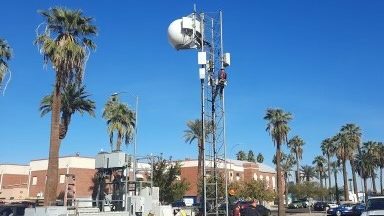The bulk of the three national carriers’ capacity for Super Bowl 57 is on their 5G networks
The Philadelphia Eagles and the Kansas City Chiefs aren’t the only ones who have been preparing for this weekend’s Super Bowl LVII—operators have been building out additional capacity for the past year or more, ahead of the marquee football event of the year that puts incredibly high pressure on wireless networks in and around the stadium.
T-Mobile US said that it has spent the past 12 months doing work in the Phoenix, Arizona area that has amped up speeds by “10x inside State Farm Stadium and by 4x across the region,” including 2.5 GHz support on indoor and outdoor Distributed Antenna Systems, launching 600 megahertz of millimeter-wave spectrum and capacity upgrades with small cells, new sites and “enhanced backhaul”. AT&T says it has added thousands of antennas inside and outside the stadium, including 64 outdoor antennas supported by 15 miles of fiber and power cabling and capacity improvements across its 700 MHz, midband and mmWave 5G as well as its LTE network, and additional deployables to support public safety communications across the metro Phoenix area. Verizon, meanwhile, says that it installed around 1,400 mmWave antennas in the upper and lower bowls of the stadium, plus additional antennas on the concourses, to a density of one antenna serving about 38 customers; and carried its mmWave and C-Band capacity enhancements to central areas of Phoenix as well as neighboring cities for a consistent experience.
Network testing and analysis firm Signals Research Group happened to be in Phoenix in mid-January, and put out a report this week on its observations on carriers’ available capacity based on drive-testing around the stadium, using a Rohde & Schwarz scanner as well as Samsung Galaxy S22 smartphones for each carrier to look at available active spectrum and capacity.
The report’s findings are specific to capacity outside the stadium and doesn’t account for in-building assets that will boost capacity further, or for deployable assets, such as Cells on Wheels (COWs) that may have been deployed to the site, or turned up, after SRG’s visit.
Among the findings of interest:
-For all three operators, SRG estimated that 5G accounted for more than 75% of their potential network capacity.
-For T-Mobile US in particular, its mid-band 5G spectrum assets accounted for 97% of its potential capacity, and for AT&T, its mid-band 5G holdings provide around 90% of its total 5G capacity (SRG also encountered some AT&T mmWave sites in its drive-testing.)
-Verizon’s 5G accounted for 77% of its available capacity, mostly due to its “heavy use of CBRS spectrum, which gave it much higher LTE capacity than its peers,” SRG said. By SRG’s reckoning, CBRS-related radio assets accounted for nearly half (49%) of Verizon’s available LTE capacity. Meanwhile, Verizon’s 5G mmWave spectrum represented 69% of its available 5G capacity.
-SRG made note that a recent software update to the Galaxy S22 smartphones that it used in testing allowed the use of AT&T’s new 3.45 GHz spectrum for aggregation with other bands.
More details from SRG here.

